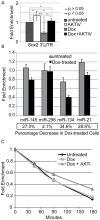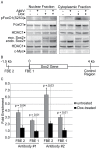Sox2 expression is regulated by a negative feedback loop in embryonic stem cells that involves AKT signaling and FoxO1
- PMID: 24116102
- PMCID: PMC3792943
- DOI: 10.1371/journal.pone.0076345
Sox2 expression is regulated by a negative feedback loop in embryonic stem cells that involves AKT signaling and FoxO1
Abstract
The self-renewal and pluripotency of embryonic stem cells (ESC) is regulated by a highly integrated network of essential transcription factors, which includes Sox2. Previous studies have shown that elevating Sox2 on its own in mouse ESC induces differentiation and inhibits the expression of endogenous Sox2 at the protein and mRNA level. These findings led us to hypothesize that increases in Sox2 activate a negative feedback loop that inhibits the transcription of the endogenous Sox2 gene. To test this hypothesis, we used i-OSKM-ESC, which elevate Sox2 in conjunction with Oct4, Klf4, and c-Myc when treated with doxycycline (Dox). Elevating the expression of these four transcription factors in i-OSKM-ESC does not induce differentiation, but it represses expression of endogenous Sox2. We determined that increases of Sox2 in i-OSKM-ESC lead to increases in activated AKT and inactivation of FoxO1 (an activator of Sox2), as well as decreases in binding of FoxO1 to the 5'flanking region of Sox2. Importantly, we determined that inhibition of AKT in Dox-treated i-OSKM-ESC leads to re-expression of endogenous Sox2 at the mRNA and protein level and reactivation of FoxO1. These findings argue that AKT signaling is part of the negative feedback loop that helps carefully control the transcription of Sox2 in ESC by modulating the binding of FoxO1 to the Sox2 gene. Collectively, our findings provide new insights into the mechanisms that enable ESC to carefully regulate the levels of Sox2 and retain their stem cell properties.
Conflict of interest statement
Figures








Similar articles
-
FOXO1 is an essential regulator of pluripotency in human embryonic stem cells.Nat Cell Biol. 2011 Jul 31;13(9):1092-9. doi: 10.1038/ncb2293. Nat Cell Biol. 2011. PMID: 21804543 Free PMC article.
-
Determination of protein interactome of transcription factor Sox2 in embryonic stem cells engineered for inducible expression of four reprogramming factors.J Biol Chem. 2012 Mar 30;287(14):11384-97. doi: 10.1074/jbc.M111.320143. Epub 2012 Feb 9. J Biol Chem. 2012. PMID: 22334693 Free PMC article.
-
Proteomic analysis of Sox2-associated proteins during early stages of mouse embryonic stem cell differentiation identifies Sox21 as a novel regulator of stem cell fate.Stem Cells. 2010 Oct;28(10):1715-27. doi: 10.1002/stem.494. Stem Cells. 2010. PMID: 20687156 Free PMC article.
-
Concise review: The Sox2-Oct4 connection: critical players in a much larger interdependent network integrated at multiple levels.Stem Cells. 2013 Jun;31(6):1033-9. doi: 10.1002/stem.1352. Stem Cells. 2013. PMID: 23401375 Free PMC article. Review.
-
Sox2/Oct4: A delicately balanced partnership in pluripotent stem cells and embryogenesis.Biochim Biophys Acta. 2016 Jun;1859(6):780-91. doi: 10.1016/j.bbagrm.2016.03.006. Epub 2016 Mar 23. Biochim Biophys Acta. 2016. PMID: 26992828 Review.
Cited by
-
SOX2 Promotes Invasion in Human Bladder Cancers through MMP2 Upregulation and FOXO1 Downregulation.Int J Mol Sci. 2022 Oct 19;23(20):12532. doi: 10.3390/ijms232012532. Int J Mol Sci. 2022. PMID: 36293387 Free PMC article.
-
Endogenous fluctuations of OCT4 and SOX2 bias pluripotent cell fate decisions.Mol Syst Biol. 2019 Sep;15(9):e9002. doi: 10.15252/msb.20199002. Mol Syst Biol. 2019. PMID: 31556488 Free PMC article.
-
Molecular and functional interactions between AKT and SOX2 in breast carcinoma.Oncotarget. 2015 Dec 22;6(41):43540-56. doi: 10.18632/oncotarget.6183. Oncotarget. 2015. PMID: 26498353 Free PMC article.
-
Quantitative comparison of single-cell RNA sequencing versus single-molecule RNA imaging for quantifying transcriptional noise.bioRxiv [Preprint]. 2024 Aug 10:2024.08.09.607289. doi: 10.1101/2024.08.09.607289. bioRxiv. 2024. PMID: 39149226 Free PMC article. Preprint.
-
Nephronectin plays critical roles in Sox2 expression and proliferation in dental epithelial stem cells via EGF-like repeat domains.Sci Rep. 2017 Mar 27;7:45181. doi: 10.1038/srep45181. Sci Rep. 2017. PMID: 28345658 Free PMC article.
References
-
- Niwa H, Miyazaki J, Smith AG (2000) Quantitative expression of oct-3/4 defines differentiation, dedifferentiation or self-renewal of ES cells. Nat Genet 24: 372–376. - PubMed
-
- Kopp JL, Ormsbee BD, Desler M, Rizzino A (2008) Small increases in the level of Sox2 trigger the differentiation of mouse embryonic stem cells. Stem Cells 26: 903–911. - PubMed
-
- Okumura-Nakanishi S, Saito M, Niwa H, Ishikawa F (2005) Oct-3/4 and Sox2 regulate oct-3/4 gene in embryonic stem cells. J Biol Chem 280: 5307–5317. - PubMed
Publication types
MeSH terms
Substances
Grants and funding
LinkOut - more resources
Full Text Sources
Other Literature Sources
Molecular Biology Databases
Research Materials
Miscellaneous

